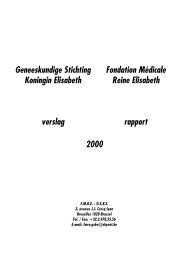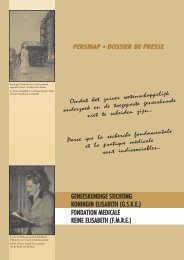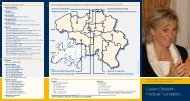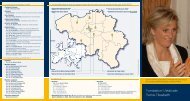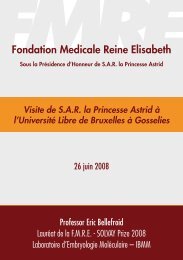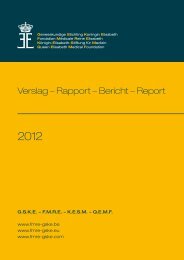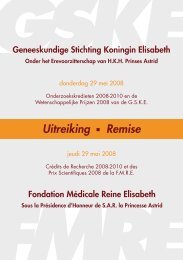Geneeskundige Stichting Koningin Elisabeth verslag - GSKE - FMRE
Geneeskundige Stichting Koningin Elisabeth verslag - GSKE - FMRE
Geneeskundige Stichting Koningin Elisabeth verslag - GSKE - FMRE
Create successful ePaper yourself
Turn your PDF publications into a flip-book with our unique Google optimized e-Paper software.
Thus, each CS from each of the PC types were classified into three types, CS type 1, CS type<br />
2, or CS type3 (Fig. 2B). When the threshold was 0, PC type 1 had equivalent number of CSs in<br />
all CS types, PC type 2 included significantly more CS type 2, and PC type 3 included more CS<br />
type 3 (Fig 2C). As the threshold was increased (see Methods), CS type 1 in PC type 1 reached<br />
the 100 % level faster than CSs in the other PC types (Fig. 2D), while the difference between<br />
CS type2 and CS type 3 was conserved up to threshold 5 (Fig. 2E). Although in PC types there<br />
were all CS types, CS type 2 and CS type 3 in PC type 1 was weaker than those were in PC type<br />
2 and PC type 3.<br />
Interaction between the complex spike and simple spiking before and after<br />
When the mean firing rates of SSs before and after a CS were compared for the classification<br />
of PCs, it was not possible to look at the exact pattern of SS around a CS. In a second study of<br />
the SS firing, three consecutive ISIs between SSs and pauses before and after a CS in each PC<br />
type were measured and compared to a simulated PC spike train constructed from the same<br />
recording to look for deviations from random behavior (see Methods). ISI distribution in total<br />
spike trains of reconstructed SSs and CSs were similar to that from original data (Fig. 3A). The<br />
distribution of three consecutive ISIs between SSs and the pause before and after a CS could<br />
show a shift either to left (+1), right (-1), or no shift (0) (Fig 3B). Pauses after a CS were<br />
significantly longer than that from simulation in all PC types, but pauses before a CS seemed<br />
to be a random. While the ISI after a CS shows the same characteristics for PC type 1, PC type<br />
2 and PC type 3, the ISI before a CS were lengthened compared to the result in simulation (Fig.<br />
3C).<br />
45



